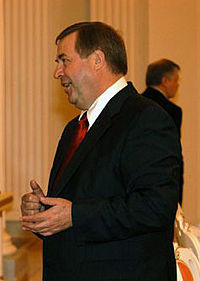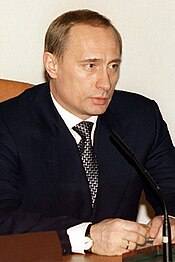2nd State Duma
 From Wikipedia - Reading time: 6 min
From Wikipedia - Reading time: 6 min
of the 2nd convocation | |||||
|---|---|---|---|---|---|
| |||||
 Seat composition of the 2nd State Duma | |||||
| Overview | |||||
| Meeting place | State Duma building Moscow, Okhotny Ryad street, 1 | ||||
| Term | 17 January 1996 – 24 December 1999 | ||||
| Election | 1995 parliamentary election | ||||
| Government | 27 committees | ||||
| Website | State Duma | ||||
| Members | 450 | ||||
| Chairman | Gennady Seleznyov (from Communist Party) | ||||

The State Duma of the Federal Assembly of the Russian Federation of the 2nd convocation (Russian: Государственная Дума Федерального Собрания Российской Федерации II созыва) is a former convocation of the State Duma, Lower House of the Russian Parliament. The 2nd convocation meets at the State Duma building in Moscow, worked from December 17, 1995 – December 19, 1999.
Leadership
[edit]
The first meeting of the 2nd State Duma was moderated by the oldest deputy, 73 year-old Grigory Galaziy.
On January 17, 1996, the parliament elected Gennady Seleznyov as the Chairman of the State Duma.[1]
| Office | MP | Period | Parliamentary affiliation | ||
|---|---|---|---|---|---|
| Chairman | Gennady Seleznyov | 17 January 1996 – 18 January 2000 | Communist Party | ||
| First Deputy Chairmen | Alexander Shokhin | 18 January 1996–5 September 1997 | Our Home – Russia | ||
| Vladimir Ryzhkov | 10 September 1997–3 February 1999 | Democratic Choice | |||
| Boris Kuznetsov | 17 February 1999–18 January 2000 | Our Home – Russia | |||
| Deputy Chairmen | Sergey Baburin | 18 January 1996–18 January 2000 | Russian All-People's Union | ||
| Svetlana Goryacheva | 18 January 1996–18 January 2000 | Communist Party | |||
| Mikhail Gutseriyev | 18 January 1996–18 January 2000 | Liberal Democratic Party | |||
| Artur Chilingarov | 18 January 1996–18 January 2000 | Regions of Russia | |||
| Mikhail Yuryev | 20 March 1996–18 January 2000 | Yabloko | |||
Chairman election
[edit]| Candidate | First ballot | Second ballot | Third ballot | ||||
|---|---|---|---|---|---|---|---|
| Votes | % | Votes | % | Votes | % | ||
| √ Gennady Seleznyov (CPRF) | 216 | 48.0% | 219 | 48.7% | 231 | 51.3% | |
| Ivan Rybkin (IND) | 166 | 36.9% | 51 | 11.3% | 150 | 33.3% | |
| Vladimir Lukin (Yabloko) | 56 | 12.4% | 50 | 11.1% | |||
| Source:[2] | |||||||
Factions and groups
[edit]| Faction | Seats | ||
|---|---|---|---|
| Communist Party of the Russian Federation | 139 | ||
| Our Home – Russia | 65 | ||
| Liberal Democratic Party of Russia | 49 | ||
| Yabloko | 45 | ||
| Regions of Russia - Independent MPs | 44 | ||
| Narodovlastie | 41 | ||
| Agrarian Party of Russia | 35 | ||
| Independent MPs | 19 | ||
| Democratic Choice of Russia | 6 | ||
| Vacant | 7 | ||
Major legislation
[edit]Five Prime Ministers were approved by the State Duma of the second convocation.[3]
- August 10, 1996: Viktor Chernomyrdin re-approved as Prime Minister of Russia with 314 votes in favor.
- April 24, 1998: Sergei Kiriyenko approved as Prime Minister of Russia with 251 votes in favor.
- September 11, 1998: Yevgeny Primakov approved as Prime Minister of Russia with 317 votes in favor.
- May 19, 1999: Sergei Stepashin approved as Prime Minister of Russia with 301 votes in favor.
- August 16, 1999: Vladimir Putin approved as Prime Minister of Russia with 233 votes in favor.
Attempted impeachment of Boris Yeltsin
[edit]The procedure of impeachment of Boris Yeltsin was initiated in May 1999 on the basis of five charges: the collapse of the Soviet Union; 1993 constitutional crisis; the outbreak of War in Chechnya; weakening the country's defense and genocide of the Russian people.
Was formed a special Commission under the leadership of Vadim Filimonov.
On May 15, 1999, the vote to impeach Yeltsin was held, but none of the accusations received the necessary 300 votes.[4]
| Accusation(s) | Voice of factions | Result | ||||||||
|---|---|---|---|---|---|---|---|---|---|---|
| Communist Party | Liberal Democratic Party | Our Home – Russia | Yabloko | Agrarian Party | Narodovlastie | Regions of Russia | Independent | Democratic Choice of Russia | ||
| Collapse of the Soviet Union | 127 | 1 | 1 | 5 | 35 | 43 | 20 | 9 | 0 | 239/300 |
| 1993 constitutional crisis | 128 | 2 | 0 | 24 | 35 | 43 | 22 | 9 | 0 | 263/300 |
| War in Chechnya | 128 | 1 | 1 | 37 | 35 | 42 | 22 | 12 | 0 | 283/300 |
| Weakening the country's defense | 127 | 2 | 2 | 3 | 35 | 43 | 20 | 9 | 0 | 241/300 |
| Genocide of the Russian people | 127 | 2 | 2 | 0 | 35 | 43 | 19 | 9 | 0 | 238/300 |
Committees
[edit]In the State Duma of the 2nd convocation operated 27 Committees.
- Committee on law and judicial and legal reform
- Veterans Affairs Committee
- Committee of Labour and Social Policy
- Committee on Budget, Taxes Banking and Finance
- Committee on Economic Policy
- Committee on Property, Privatization and economic activity
- Information Policy Committee
- Committee on Energy, Transport and Communications
- Committee on Industry, Construction and High Technology
- Education and Science Committee
- Culture and Tourism Committee
- Health Protection Committee
- Committee on Women, Family and Youth
- Committee on Agrarian Issues
- Defence Committee
- Safety Committee
- Committee on International Affairs
- Committee on Commonwealth of Independent States Affairs and Relations with Compatriots
- Committee on Rules and Organization of the State Duma
- Problems of the North Committee
- Committee on Geopolitics
- Committee on Federation Affairs and Regional Policy
- Committee on Local Government
- The Environmental Committee
- Committee on Natural Resources and the Environment
- Committee on Public Associations and Religious Organizations
- Committee for Nationalities
 KSF
KSF



